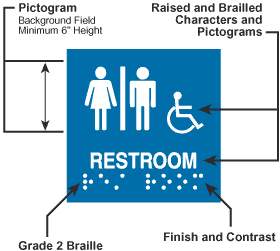ADA and Means of Egress
Posted on - Friday, January 24th, 2014The 2010 ADA as well as the 2012 Texas Accessibility Standards have changed the requirements for means of egress. There are several new ways of looking at it in terms of accessibility. There are elements that are scoped by referencing other standards, such as IBC. There are new requirements for signage as well as stairs. This newsletter will attempt to shed some light on the confusing rules about means of egress and building access.
207 Accessible Means of Egress
In the 1991 ADAAG and the 1994 TAS, the requirements for accessible means of egress were that 100% of the required means of egress should be accessible. In the 2010 ADA Standards the new requirement is to follow the IBC 2000 Section 1003.2.13 or Section 1007 of the IBC 2003 Edition.
The big confusion is what happens if the municipality we are building under uses a different version? ADA Section 105 which discusses referenced standards states:
“105.2 Referenced Standards. ….Where differences occur between this document and the referenced standards, this document [2010 ADA Standards] applies.”
However building codes reminds us that the most strict rule will govern. In the IBC 2006, Section 102 Applicability:
102.1 General.
Where, in any specific case, different sections of this code [IBC 2006] specify different materials, methods of construction or other requirements, the most restrictive shall govern. Where there is a conflict between a general requirement and a specific requirement, the specific requirement shall be applicable.
102.2 Other laws.
The provisions of this code [IBC 2006] shall not be deemed to nullify any provisions of local, state or federal law.
Even though the means of egress is not scoped by the ADA, the doors are scoped. Although doors are scoped only as part of entrances, exit doors are essentially “entrances” to the exterior. Therefore the maneuvering clearances and other requirements for interior doors that are along the accessible route and means of egress would be scoped by section 404. Exit stairs may or may not be part of an accessible route. Each condition should be examined before your design is complete to ensure whether you are required to comply.

Signage at Exits
ADA Section 216.4 explains that signs for means of egress and area of refuge are required to be located at exit doors, exit passageways, exit discharge, and exit stairways. To understand what requirements these signs must follow, the scoping section refers you to the following technical sections (which we will explained below):
703.1 General, 703.2 Raised Characters (which also references 703.3: Braille and 703.4:Installation Height) and 703.5 Visual (which also refers you to 703.3).

703.1 General
This section explains that both visual and tactile characters must be provided in an exit sign, and that these can either be in one sign, or separate signs for each type of characters.
703.2 Raised Characters
Raised characters are letter, numbers or other identifying characters that have a three dimensional feel. This section gives us guidance on the depth, case, style, proportions, height, stroke, character spacing and line spacing.


Only San Serif Fonts and all capital letters are allowed to be used for raised characters
In addition to the requirements in 703.2 , this section also tells us that the raised characters must be duplicated in Braille whose requirements are found in section 703.3, as well as to be installed as described in 703.4.


703.5 Visual Characters
Visual characters are also called “Pictograms”. They are symbols rather than words and numbers. This section explains that visual characters should have a background with a contrast and non-glare finish. In addition, there are similar requirements as raised characters on case, style, braille, height from finished floor etc.

The visual character (or pictogram) of the fire extinguisher is duplicated in Braille as well as in raised letters
Note: one of my difficulties with the 2010 ADA is that even though the scoping tells us to follow certain sections, when we read the technical sections there will be more sections to follow. The reader has to be very careful not to miss any pertinent information along the way.
More Resources
Thank you for your interest in these topics and allowing me to share them with you. May your 2014 be full of success, health and happiness to your staff and family! May we continue to assist in removing barriers for all.
If you want to learn more about thes Standards and how they apply to your building types, be sure to check out my books: “The ADA Companion Guide” and “Applying the ADA” (also available in e-book)
If you have any questions about these or any other topics, please feel free to contact me anytime.
Marcela Abadi Rhoads, RAS #240
Abadi Accessibility
214. 403.8714
marhoads@abadiaccess.com
www.abadiaccess.com
 Abadi
Abadi 
